Just over a year ago, Indonesia’s last private-owned regular scheduled airline from the previous century, Mandala, closed it’s doors. It was a sad moment for the industry, the only old players on the scheduled markets, were state-owned airlines, Garuda and Merpati.
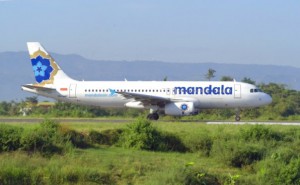 |
|
Mandala A320 prior to it’s temporary suspension
(Photo by: Christ Moris)
|
The radical turnaround in 2007-2009 was successful on the product end. Mandala bucked the trend of the Indonesian airline industry by adopting a hybrid business model. The first few rows of the aircraft was allocated for business passengers, it was literally bringing the European business class model to Indonesia, while the rest of the cabin was what you’d expect from a low-cost carrier.
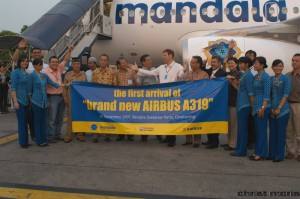 |
|
Former CEO Warwick Brady (now in Easyjet) greets
Mandala’s first A319 after it’s delivery flight in 2007 (Photo by: Christ Moris)
|
It moved from a fleet mix of 737-200s and 737-400s to an all Airbus fleet by 2009. It also attacked its safety problem and reputation caused by years of heavy domestic competition and culminated in being one of (if not the) first Indonesian carrier to get IOSA certification and was in the first batch of airlines to be exempted from the EU ban on safety.
My “jigged” statistics based on limited data was enough to show the market success. It had the highest growth in passenger numbers and load factor in Indonesia in 2009, not an easy feat! It had also the most productive seat in any airline Indonesia, each seat carrying more passengers in a year than any other airline.
My “jigged” statistics based on limited data was enough to show the market success. It had the highest growth in passenger numbers and load factor in Indonesia in 2009, not an easy feat! It had also the most productive seat in any airline Indonesia, each seat carrying more passengers in a year than any other airline.
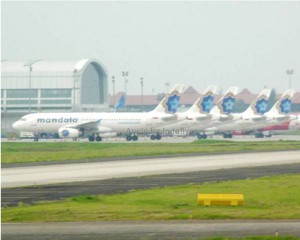 |
|
The 5 remaining Mandala A320s the day after it’s
suspension (Photo by: Mochamad Aswin)
|
Unfortunately, these successes were not backed by adequate investment. Cardig and Indigo owned Mandala, the latter reportedly imported Indonesia’s first foreign airline CEO, Warwick Brady, intending to use his experience in Ryanair and Air Deccan to turn Mandala into a major Low-Fare and Low-Cost carrier (Low-Fare dominated by Lion, and Low-Cost dominated by Air Asia). Cardig however, wanted to make Mandala into a premium carrier which was against the industry trend at the time. Brady, did his own work and settled on a compromise hybrid model. This did not please Indigo, who then refused to put in additional money into Mandala, and Cardig refused to put in money unless Indigo does so too. This lead to the efficiency drive which needed money for severance pays and restructuring to never making it beyond paper. The end was inevitable, Brady left, and former CEO Diono Nurjadin took over trying to save whatever is left, only to announce in January 2011 that Mandala was to cease operations pending restructuring.
Two Mandala Air pilots thanked their aircraft prior to delivering them back to lessors
(Photos courtesy of Capt. Ditto Arya)
The Cardig-Indigo partnership for Mandala was scrapped, in comes Saratoga Investments and Singapore’s Tiger Air, and now Mandala has got it’s AOC back and has announced it will start flying on 4th April with a very noticeable Tiger Air influence for its initial routes:
- Jakarta-Singapore
- Medan-Singapore
- Denpasar (Bali)-Singapore
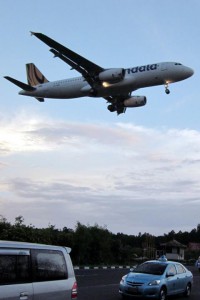 |
| Mandala’s new brand is Mandala in title only – PK-RMN approaching Bali on a proving flight. (Photo by: Efendi Tanuliadi) |
What does Tiger-Mandala tie-up mean?
1. Mandala brand to disappear! This is the saddest part of it all. Mandala is a legendary name in Indonesian aviation, with its 40 years (or thereabouts) brand baggage! The long gone Mandala Wheel isn’t going to come back, and the “Mandala Sakura” (as my friends call it) introduced in 2007 isn’t coming back either. Instead, see the photo on the left.
2. Mandala’s “Cyan Pants Squadron” uniform is to disappear. This goes along with the rebranding. However, I need to get this confirmed.
3. Value-Added Carrier business strategy to be dumped. The 2007-2010 business model relying on the “Business for value” product is not returning as Mandala will align the product strategy with Tiger Air. In 2007-2010 Mandala’s product success lies in the product aimed at business passengers, with the business economy product (to which the name eludes my memory), whereby the first few rows are dedicated to business passengers travelling on full fares with lounge access, preferred check-in, and inclusive meals, made it the second choice after Garuda for many companies, and the preferred carrier over Garuda for not so few big companies.
Those who avoid “cheap and nasty low-fare and low-cost carriers” will have to wait and see if the changed Tiger product proposition is that, or has moved towards value-added products (such as Air Asia), or will the ground part of the product reflect Tiger’s “not-so-bright” past.
It appears the aviation authorities in Indonesia is prohibiting Mandala from changing it’s brand name totally, but it appears that nothing can stop the brand and product alignment with Tiger.
Questions in the public’ mind remain:
- Will Tiger-Mandala be able to compete against Indonesia Air Asia and Lion Air on the low-cost and low-fare market segment?
- How is Mandala going to resolve the ticket refund issue it froze last year?
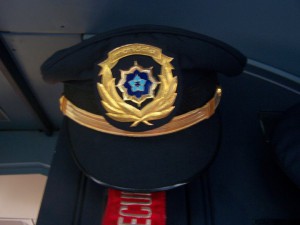 |
| This may be the last Mandala brand identity to remain, on the pilot uniforms (Photo courtesy of Capt. Ditto Arya) |

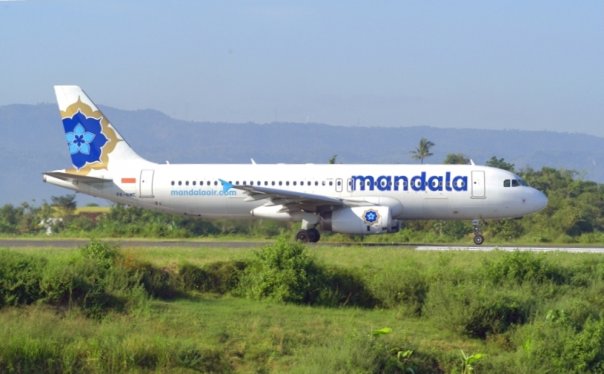
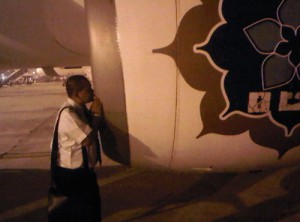
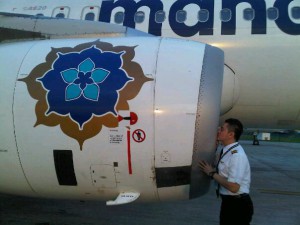
It sadden how good airlines dies only because the ego of the owner. Mandala may buried forever, but there will be always an airline that will continue their unfinished dreams